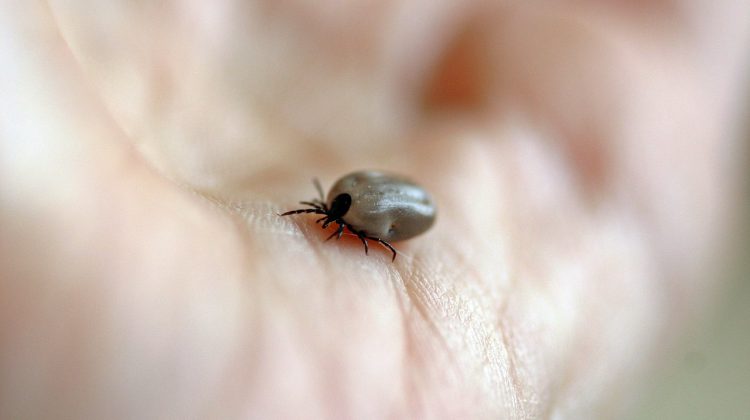As Spring rolls into Ontario in full force, the province wants to make sure everyone is aware of ticks and Lyme disease.
Ontario’s Chief Medical Officer of Health Dr. Keiran Moore answered some frequently asked questions and fact-checked some common myths about ticks on Wednesday (May 17).
Which ticks are the biggest threat to humans and dogs in Ontario/ Eastern Ontario/ Northern Ontario?
“In terms of transmission of infection, the main risk to both our pets and humans is from the black-legged tick. The science name is called Ixodes scapularis and the adult Ixodes tick is around the size of a sunflower seed. The nymph, a different stage of the tick, is around the size of a poppy seed.
So, these are quite small, and they can attach quite easily to us as we walk through the woods. Typically the ticks are located at the edge of the woods and throughout, as you have that transition from a field to the forest.
That is one of their preferred environments. Their preferred meal is actually on a small mammal like a white-footed mouse and or squirrel. Some of those brown foragers would be its preferred meal and then the adult has preferred meal on the deer so hence its name, a deer tick. But incidentally, from time to time we will get exposed, and they don’t mind where they get their blood meal from. If it’s a human, they will try to attach to us for up to three to five days and get a blood meal from us as an incidental host,” Dr. Moore says.
When do ticks become active?
“As soon as the snow is gone or the snow returns, that’s when they become quiet and dormant and try to survive our winters by borrowing low below the snow. They’re most active as the temperature increases. So, as we go through June, July, and August, that’s when we receive the highest number of positive blood tests across Ontario.
So the risk starts as soon as the snow is gone. But the nymph is very active in looking for a meal mostly in June, July, and August. But anywhere in Ontario as soon as the snow is gone, there is a risk of tick attachment and the transmission of Lyme disease,” Dr. Moore says.
Where are ticks found, and what areas should I avoid?
“We’ve been monitoring this and its ever-increasing risk across all of Ontario. It mainly started in the early 2000s in Eastern Ontario. But anywhere a bird can land as the northern migration of birds, they can drop in ticks. So really all of Ontario is at risk. There are higher risk zones along the Great Lakes and in eastern Ontario, but I’d be remiss if I didn’t say all of Ontario is a potential risk because of the bird migration and the ability for the ticks to be dropped into any part of Ontario,” Dr. Moore says.
Which diseases are transmitted by black-legged ticks?
“There are multiple that we found in Ontario. Lyme disease would be the most common one. So, in the last several years we’ve had in 2020 1700 people identified by blood tests as having the disease, and 1400 last year. So relatively high numbers for vector-borne disease.
We also have been detecting diseases called babesiosis that are just starting in Ontario. It’s quite common in the northeastern United States and those diseases typically migrate up through Eastern Ontario and across. Anaplasmosis is another bacterial infection that can be found in ticks rarely. And then a virus called Powassan disease can be transmitted by ticks. Those would be the main four diseases.
So, they are a threat and a risk to us all and hence, you know, we really need to be looking at prevention of their attachment and early identification of any illness associated with them,” Dr. Moore says.
What is the best way for PEOPLE to avoid tick bites?
“Some of the best means is to be just aware of the risk. Staying on paths if you’re going for a hike and we absolutely want Ontarians to keep active. As soon as you go off the path and you’re just brushing against some of the grasses and or leaves of low-hanging trees, that is where the ticks are and they’re just monitoring for carbon dioxide changes and temperature changes, and they’ll drop off the branch onto your foot and climb up. They’re that sensitive to movement and carbon dioxide released by us.
The means of preventing them from attaching, number one, I’d wear long pants and/or long shirts that are lightly coloured so you can identify them. These are dark-legged ticks with darker bodies and that would enable you to, number one, be protected against attachment but also identify if they’re on your clothes.
Insect repellents work, so bug sprays that contain 20 to 30% deet are also very effective. In some jurisdictions, Permethrin-impregnated clothes will help repel the attachment of ticks, but a common bug spray like DEET is very effective in preventing attachment. It’s a repellent against ticks and could also help against mosquitoes as well,” Dr. Moore says.
What is the best way for PETS to avoid tick bites?
“Pets are basically tick magnets. If they’re going out into the bush their hair is easy for the ticks to attach to. I would speak to your veterinarian, there are multiple products that can act as repellents for our pets to minimize their risk but also there’s a vaccine available for small mammals like dogs that can also decrease the risk for our pets,” Dr. Moore says.
Where am I most likely to find a tick on my body?
“If you’ve gone outdoors, all of us have to be aware, Number one of the risk, but also do a daily tick check where you’re inspecting your body and using a mirror on your back and chest to look, see and ensure that there was no attachment.
[Ticks] like quiet areas like the back of our knees, into the groin, into the armpit, the back of our hair. Where they can attach quietly. They’re quite sneaky, they have an anesthetic that numbs your skin as they try to burrow in, and then they have a cement that they secrete that allows them to stay attached for three to five days,” Dr. Moore says.
What is the best way to remove a tick?
“So removing them can be difficult, but if you have a fine nose tweezer, grab right at the head, not at the body but right at the head of the tick, and pull straight out, so perpendicular to the skin. And be calm about it because they’re really stuck in with the cement, and you need a fair bit of pressure to pull them out.
You can remove them, and you want to remove them relatively quickly before they’ve been attached for long periods of time. The longer they’re attached, the higher the risk that they’ll transmit an infection to you. You also don’t want to put Vaseline on them, or you know some people have tried to use a small match to heat them. That just annoys [the ticks] and they could spit out more ingredients through the skin and into your bloodstream.
And then wash after with soap and water and monitor for any signs or symptoms of infection. You could keep the tick in a secure bottle and that would help with the identification,” Dr. Moore says.
And what do I do with it once removed?
“There are websites where you can look and identify what type of tick it was and if you develop symptoms, you can bring that tick into your healthcare provider and ensure they get a look at the tick. They can tell from the level of size of the tick how long it potentially was attached to you and the risk of transmission.
Personally, if I took a tick off my body, I would put it in a small and sealed jar, keep it and monitor my symptoms and inform your healthcare worker that you had an attached tick,” Dr. Moore says.
What symptoms of illness should I be looking for if I removed an attached tick (human exposure)?
“For the Lyme disease risk, any time from the time of attachment to up to 30 days, we’d ask you to monitor for symptoms at the site of attachment. One of the more common symptoms is an expanding red rash. Some have called it a bullseye-type rash, but it can be any red. Typically bigger than 10 centimeters and it can expand even further to 20, 30, or 40 centimeters. That would be the hallmark classical sign and you can look that up online to see if your rash looks like erythema migrans. I would hope most healthcare workers should be able to identify that rash as being Lyme disease rash. Around 70% of people will get that and it’s easily identifiable.
And then the treatment is an antibiotic that can be very effective at decreasing any further risk from Lyme disease. You will or may have associated symptoms like a fever, chills, headache, sore neck, sore joints, and muscles, fatigue, or swollen lymph nodes. Those would also be the hallmark symptoms of early Lyme disease.
But it is a complicated disease because if it’s not treated initially or you don’t get that classic rash, the bacteria will want to spread through your bloodstream and can affect your heart. Also, it can affect neurologic tissue or the brain and that would be what we’d call later effects of Lyme disease. And then if it’s still not treated, there’s an ongoing risk of painful inflammation in joints or arthritis. 60 percent of untreated patients may develop those severe joint and swellings typically of the large joints, knees, and hips, and that absolutely needs a healthcare worker to assess you. All of us should be telling a healthcare worker if we’ve been out at risk to have a tick attachment,” Dr. Moore says.
As for common myths some people have about ticks and Lyme disease, Dr. Moore fact-checked the following;
Everyone with Lyme disease gets a telltale bullseye rash.
“It’s roughly 60 to 70 percent that will get that telltale rash. The other way I explain it is if you get a summer flu after having been outdoors, even up to 30 days after having been out and enjoying Ontario’s wilderness. So, fever, chills, muscle aches, joint aches, headaches, or any new neurologic event, please raise the risk of Lyme disease.
Even the hallmark red rash is sometimes difficult to really call Erythema migrans and please you need to be clinically assessed. You need to raise the risk with your healthcare provider if you develop those types of symptoms,” Dr. Moore says.
Antibiotics cure Lyme disease.
“So, for early disease, absolutely. The appropriate course of antibiotics, the main antibiotic is called doxycycline, which is highly effective at eliminating the risk of that bacteria from you from your body. Some individuals still might have some post-inflammatory issues.
So just like we’ve seen with COVID and post-COVID syndrome, there is that risk of any infection, so you may need to follow up with your healthcare provider if you have any ongoing symptoms. But for most people oral antibiotic treatment absolutely decreases your risk of any complications from Lyme disease.
Rarely, 1700 individuals in 2021 were diagnosed by blood test with this disease only 87 had to be in hospital and those were mostly those that had cardiac and/or neurologic complications. So, the vast majority are treated as outpatients,” Dr. Moore says.
If the test is negative, you don’t have Lyme.
“That is a major myth. As we’ve learned from COVID, it takes a while for our bodies to make antibodies against any infection, and if you get tested early on in your illness with Lyme disease, you may not have developed antibodies yet and you may be told your test is negative. Early on the diagnosis of Lyme disease is a clinical diagnosis, which means it does not need lab confirmation.
If you have that expanding red rash with a negative test and you’ve had the exposure you should be on the treatment for Lyme disease. We should not be dependent on a positive lab test it’s a clinical diagnosis,” Dr. Moore says.
Chronic Lyme disease isn’t real.
“No, I think we’re gaining much more understanding of the long-term effects of any infection. I think long COVID is a clear example and that some of the individuals as I’ve described have had cardiac involvement or neurologic or joint involvement and it may be that antibiotics won’t be effective at decreasing some of that inflammation in the long term and that we may have to look at other therapies.
But I’m hopeful that we will learn more on how to treat long-term complications of infections given that the effort in science that has been put into understanding the implications of long COVID,” Dr. Moore says.
The black-legged tick is the only tick you need to worry about.
“No, there are other ticks that can be dropped in by bird migration into Ontario and there are risks of these other Lone Star ticks that we’ve seen from time to time in Ontario. To date, they haven’t been able to overwinter, and they are relatively rare events. But all citizen scientists can help us. If you’ve got an unusual tick that was attached to you that you’re not sure about, we do have an ability through the Internet as well through Public Health Ontario to try to identify those ticks and their risk,” Dr. Moore says.







